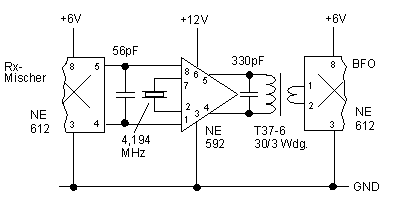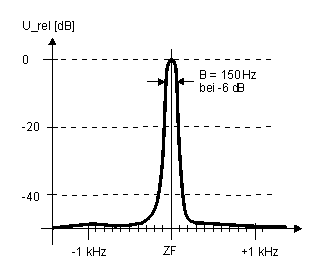Hi all,
I want to make a bandpass filter for detecting the DCF77 RF time-signal (=77.5 khz AM pulses). I was considering to use a crystal filter (I have two 77.5khz crystals) there I need to reduce distortion and other signals (BW~100Hz), but I don't have any experience with crystals.
Can anybody give me some guidelines or any kind of schematics?
Thanks in advance,
HB.
I want to make a bandpass filter for detecting the DCF77 RF time-signal (=77.5 khz AM pulses). I was considering to use a crystal filter (I have two 77.5khz crystals) there I need to reduce distortion and other signals (BW~100Hz), but I don't have any experience with crystals.
Can anybody give me some guidelines or any kind of schematics?
Thanks in advance,
HB.
I have a hunch that crystal filters in your application is too narrow if you can found one. Since the frequency is so low you can build a common bandpass filter with opamps after your first stage. If you only are interested in the digital signals it's not very important to have sharp filters.
Did you know that there are chips for time transmitters which can decode the signal, with AM reciever, complete! Don't remember the brand though, rather new chip.
Halo, maybe you can locate the chip?
Did you know that there are chips for time transmitters which can decode the signal, with AM reciever, complete! Don't remember the brand though, rather new chip.
Halo, maybe you can locate the chip?
Hey thanks!!
Indeed, there are several complete chips availlable (like the U4221b, U4226b, TCA 440, ...) But we're making a project for school, so we like to make the receiver with several components (so that the teachers can see what skills we have )
)
The major problem is that the received signal (on the antenna) is very small compared to noise and neighbour signals, so we have to make a very good filter I guess. We're also thinking about using a schmitt-trigger (after AM-demodulation) at the end of the receiver to make a clean signal.
Maybe we will mix the received signal with a sine wave of the same freq. (77.5 khz crystal osc.), making use of a double balanced mixer, and then we can filter out the DC-component with a LPF.
But I'm not sure about which method will be the best, can you help?
Best regards,
HB.
Indeed, there are several complete chips availlable (like the U4221b, U4226b, TCA 440, ...) But we're making a project for school, so we like to make the receiver with several components (so that the teachers can see what skills we have
The major problem is that the received signal (on the antenna) is very small compared to noise and neighbour signals, so we have to make a very good filter I guess. We're also thinking about using a schmitt-trigger (after AM-demodulation) at the end of the receiver to make a clean signal.
Maybe we will mix the received signal with a sine wave of the same freq. (77.5 khz crystal osc.), making use of a double balanced mixer, and then we can filter out the DC-component with a LPF.
But I'm not sure about which method will be the best, can you help?
Best regards,
HB.
Hi Hugo,
The bandwidth of the DCF time code is actually 1Hz. So a single crystal of 77.5 KHz will make a good band pass filter. This is how nearly all time code receivers work. No mixing needed at all! For minimum noise you need to know the series resistance of the x-tal. Go to your HF textbooks for minimum noise adjustment.
The bandwidth of the DCF time code is actually 1Hz. So a single crystal of 77.5 KHz will make a good band pass filter. This is how nearly all time code receivers work. No mixing needed at all! For minimum noise you need to know the series resistance of the x-tal. Go to your HF textbooks for minimum noise adjustment.
Pjotr said:The bandwidth of the DCF time code is actually 1Hz
Thanks Pjotr, but the BW of the AM-signal would be 2Hz (from lower sideband to upper sideband) if the 'information' was a sinewave of 1 Hz. With the DCF code the modulated information are square waves, so we need some higher bandwidth here, otherwise the pulses will change into small 'peaks' (see fourier analysis).
I found an interesting schematic today with an NE592 (video amplifier). This is what I found:
You'll get a narrow bandpass filter for the intermediate frequency with only one crystal used as the Z element. Maximum IF gain is at the crystals series resonance when the impedance is very low. The capacitor at the amplifier input should suppress mixing products that have a higher frequency than the IF. You cannot do without this cap because parasitic stray capacitance in parallel to the crystal causes to unwanted amplification of higher frequent signals and thus into degradation of IF selectivity. The parallel resonant circuit at the output is tuned to the IF and serves for attenuating disturbing signals due to resonant poles adjacent to the fundamental frequency. A 100 ... 220 Ohm resistor in series with the crystal can be used for getting a better filter charateristic (die out ).


I think this idea (without the mixers) is worth a try!! I couldn't find a crystal of 77.5 khz in the local store but I'll use one of an old DCF clock.
Best regards,
HB
True, so if your x-tal filter has a bandwidth of 5Hz to 10Hz that is sufficient. After demodulating the 77.5kHz time code signal, it suffices to square it up by a comparator. If you need more stages for more gain you can also couple them trough a x-tal.Thanks Pjotr, but the BW of the AM-signal would be 2Hz (from lower sideband to upper sideband) if the 'information' was a sinewave of 1 Hz. With the DCF code the modulated information are square waves, so we need some higher bandwidth here, otherwise the pulses will change into small 'peaks' (see fourier analysis).
I found an interesting schematic today with an NE592 (video amplifier). This is what I found:
Conrad (http://www.conrad.com) do sell 77.5 kHz x-tals for this purpose. But they are probably as expensive as a complete low cost DCF receiver module from Conrad. They also sell ferrite antenna’s especially for DCF receivers (tuned to 77.5 kHz)
I do not think ordering at Conrad is a problem from Belgium.
Regards
yes indeed,
I did find some 77.5khz crystals for 3.22€ at conrad!!
Thanks again! The ferrite-antenna's are delivered with a complete on the pcb, so that would be to easy for us (students)
Wednesday, we will try out a first version of our DCF-receiver, made up with ferrite-antenna and crystal from an excisting DCF-clock. Our target is to make a DCF receiver with automatic gain control, extra noise reduction with a schmitt-trigger and the output at TTL level. The next target will be an own written program to decode the time signal...
I know that there are ready 'kits' for PC/DCF applications, but this is a DIY forum as you know (hehehe).
Final schematics and results will follow if you guys are interested!
Best regards,
HB
I did find some 77.5khz crystals for 3.22€ at conrad!!
Thanks again! The ferrite-antenna's are delivered with a complete on the pcb, so that would be to easy for us (students)
Wednesday, we will try out a first version of our DCF-receiver, made up with ferrite-antenna and crystal from an excisting DCF-clock. Our target is to make a DCF receiver with automatic gain control, extra noise reduction with a schmitt-trigger and the output at TTL level. The next target will be an own written program to decode the time signal...
I know that there are ready 'kits' for PC/DCF applications, but this is a DIY forum as you know (hehehe).
Final schematics and results will follow if you guys are interested!
Best regards,
HB
- Status
- This old topic is closed. If you want to reopen this topic, contact a moderator using the "Report Post" button.
- Home
- Amplifiers
- Solid State
- anybody experienced with crystal filters??